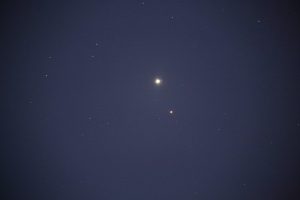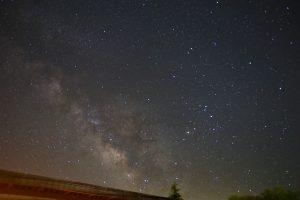The Milky Way by Honor Wheeler – Oct 2023
Four superb single shot images of the Milky Way captured by member Honor Wheeler whilst on holiday in Kelling Heath, Norfolk. In one of the photo’s there is a meteor!




Heart Nebula (IC1805) and Jellyfish Nebula (IC443) by Neil Webster

Next, see below; is a fantastic widefield image of the Jellyfish Nebula taken by Neil on the 21st January 2023.
The Jellyfish Nebula; also known as IC443 and Sharpless 248 (Sh2-248) is a galactic supernova remnant (SNR) in the constellation Gemini. On the plane of the sky, it is located near the star Eta Geminorum. Its distance is roughly 5,000 light years from Earth.
The glowing cosmic tendrils and bulbous ‘head’ are what give this deep-sky object its name, as it resembles a jellyfish. The Jellyfish Nebula is all that remains of a massive star that ran out of fuel and exploded as a supernova, leaving behind a shell of glowing gas. IC 443 has an angular diameter of 50 arcmin, the full moon by comparison, is 30 arcmin across.

Check out Neil’s flickr page at https://www.flickr.com/photos/137388222@N05/
Early Morning Planets
Members Jim Burchell, Diane Clarke and Richard Bohner were up very early on the 29th May 2022 to do a bit of planet spotting.
Jim captured the Mars & Jupiter conjunction from Dartford at 3.30am and a little bit later Saturn with Mars & Jupiter.
Mars & Jupiter

Mars, Jupiter & Saturn

Meanwhile Diane Clarke captured Jupiter & Mars and then Venus from Belvedere at 4am.
Jupiter & Mars

Venus above a cloud bank

Then 8 hours later in Arizona member Richard Bohner captured Mars & Jupiter (with Moons) too in the early morning sky. Richard said ‘It was very windy this morning and was having camera shake in some of my photos. These are 3 second images at ISO 2500.’
Mars & Jupiter from Arizona.


Richard Bohner – Milky Way – Arizona
Member Richard Bohner took the opportunity to photograph the Milky Way from his back garden on the 26th May 2022 and these are the results…….stunning!
Richard said ‘Was outside last night taking a few photos. a perfect night. It was 22C, wind – calm, no moon , “seeing” was very good and steady. These photos were taken with Canon 6D with Canon wide angle telephoto set at 24mm and 16 mm, f2.8. ISO 4000, exp time 20 seconds. Single frame.‘
These images were taken at 01:30 AM, AZ time. Scorpius is just above pine tree top and the Tea Pot just above roof line to left of galaxy.


Hyades, Pleiades and the Moon

Orion
Images by Leigh Slomer

Winner of the Milkyway from your backyard competition
The winner has been announced, every image was great but there has to be a winner and our congratulations goes to Richard Bohner of Arizona (yes he is a member of CMHASD) with this marvellous image taken from his back yard.
Milkyway from my back yard competition
This is a simple competition, take an image of the Milkyway from your back garden – or close to where you live. The winning image will be the one that the webmaster is most impressed with.
Rules:
- You have to be a member of the society
- No telescopes! This is for camera and lens only!
- Must be from your location not some superb dark sky you travelled to.
- Ends November-ish
What will impress the Webmaster most?
- It’s all about effort taken and obstacles overcome.
- Local sky conditions vs image captured
Good luck!



The Moon Saturn and Jupiter
Image by Steve Goldson.

The Pleiades, Mars and the California Nebula
In April 2019 Mars was close to M45 (the Pleiades) and NGC 1499 and this coincided with the Kelling Heath Star Party. Unfortunately at this time of year Taurus is very low, setting in the late evening making this a difficult object to image, my attempts to stack and then process with Deep Sky Stacker were hopeless, so I turned to Astro Pixel Processor (using a 30 day free trial) which has a very easy to use light pollution killer, this allowed me to remove the gradient that resulted from the very low elevation and trees that crept into the field.
Total exposure is 84 minutes, from 30s subs. Tracking was achieved with an iOptron Star tracker, camera was a Canon 600D with a full spectrum mod and a CLSCCD clip-in filter.
All images are copyright. Permission must be sought to from the image owner to the use of any of these images.





